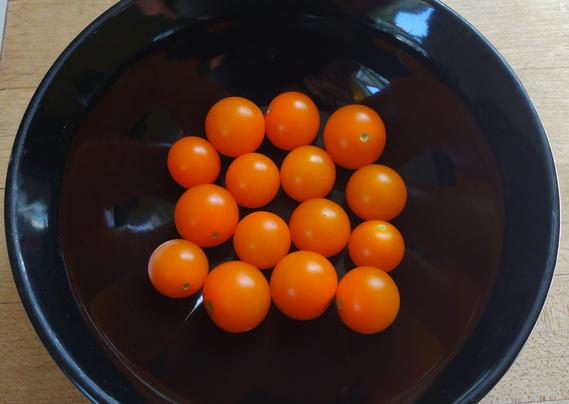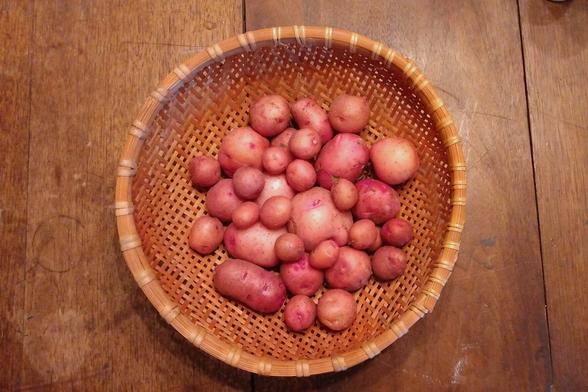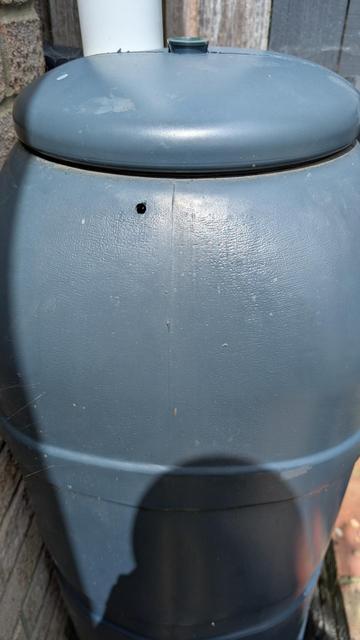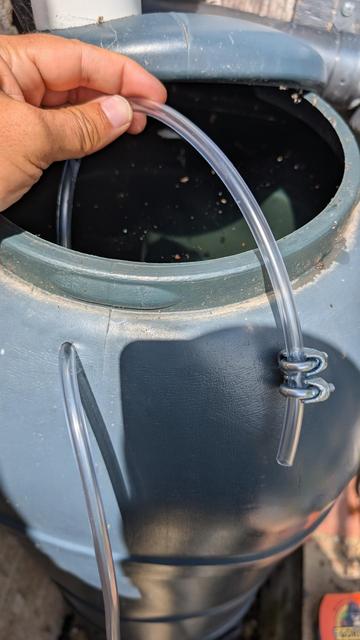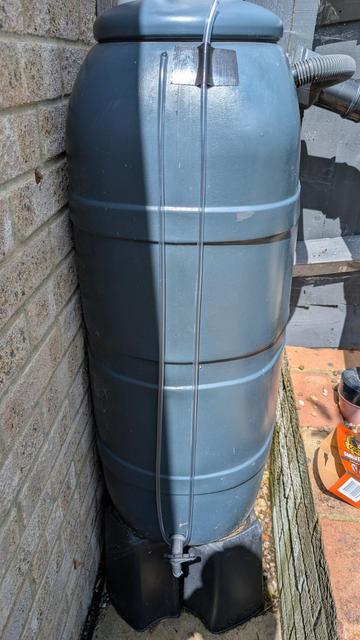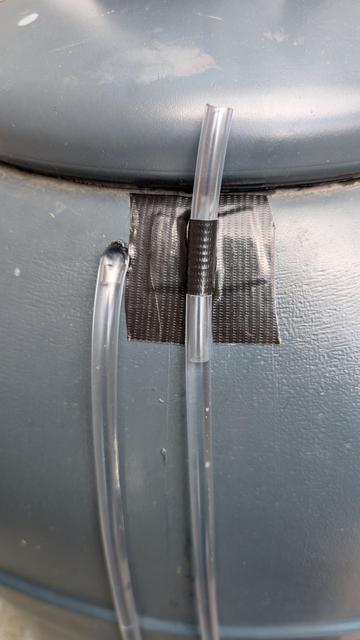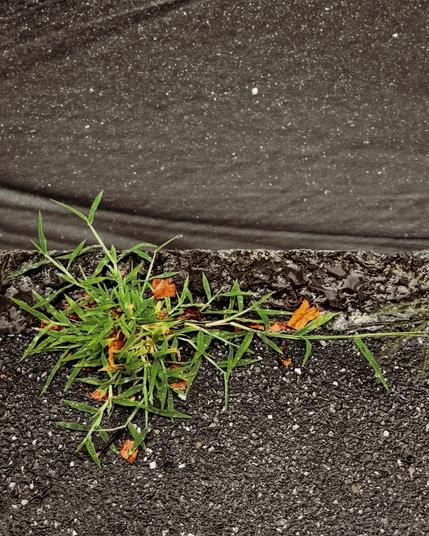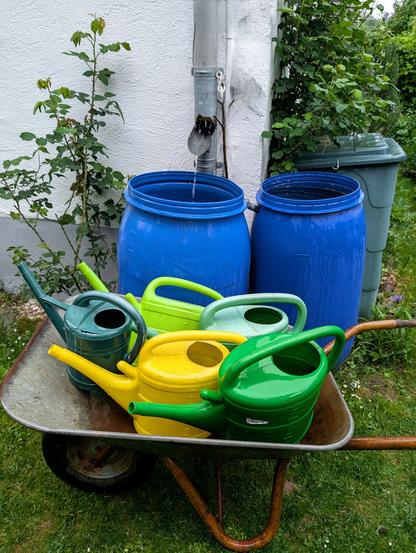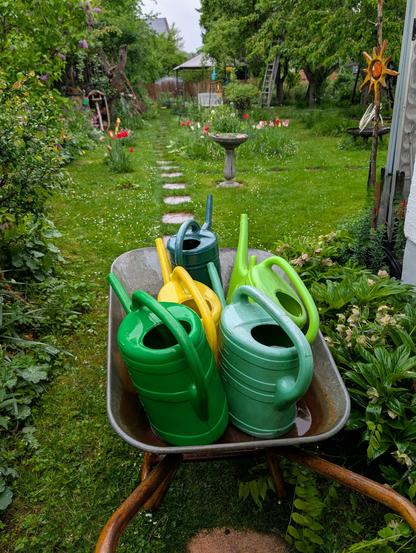I still am utterly baffled at cities that have bans on rainwater collection.
And I think about this at least a few times a year.
#RainWater
Is Collecting #Rainwater Illegal? Here’s What You Need to Know
The tomatoes are winding down (we've had plenty the last couple of months), but the potato harvest is just beginning! I managed to win the battle against hornworms, potato bugs, and #ClimateChange (using collected #rainwater whenever possible to water them). Next weekend, we'll have some "gourmet" red potatoes for dinner!
#SolarPunkSunday #Gardening #ClimateChangeGardening #GrownYourOwn #SunGoldTomatoes #MainePotatoes
Could This #Arizona Ranch Be a Model for #Southwest Farmers?
Oatman Flats has undergone a dramatic transformation, becoming the Southwest’s first #Regenerative #Organic Certified farm and a potential source of ideas for weathering #ClimateChange.
" 'We embraced the abundance of #heirloom and native crops in the #SonoranDesert,' Hansen said. 'We are looking at the land and asking it what we should grow, rather than asking the land to grow what we want.' " - Dax Hansen, owner of Oatman Flats Ranch.
By Samuel Gilbert
May 12, 2025
Excerpt: "Regeneration Rooted in #Indigenous Practices
"Southern Arizona’s rich agricultural history stretches back more than 5,000 years. By 600 CE, the Hohokam people were constructing North America’s largest and most elaborate irrigation systems along the Salt and Gila Rivers. The descendants of the Hohokam—the Pima and Tohono O’odham—continued to farm the land up to and after the arrival of the Spanish, who began to colonize southern Arizona in the 1600s. They continue to farm in Arizona today.
"At the Tohono O’odham Indian Reservation, about two hours southeast of Oatman Flats, the San Xavier Co-op Farm uses historic land management practices and grows traditional crops that reflect their respect for the land, plants, animals, elders, and the sacredness of water.
"San Xavier Farm Manager Duran Andrews and his team plant #CoverCrops, rotate fields, and collect #rainwater.
" '[Regenerative agriculture] is nothing new to us,' Andrews said. 'We have been doing this for decades. Harmony between nature and people has been our approach all the time.' Rotating fields and cultivating multiple mutually beneficial species in the same fields improves water and soil quality and biodiversity in this harsh landscape.
" 'You’ve seen what the land looks like in five years; imagine it in 10. If we can do it here, we can do it anywhere.'
"The co-op grows a variety of native crops that were developed in the region and cultivated for centuries or, in some cases, millennia, such as grains and beans, which they sell online. 'We irrigate them till they sprout, then cut them off till the monsoon shows up,' Andrews said. 'We try to keep crops in that hardy state through all the years and decades they have been here. We try not to get away from how things were done in the past.'
"They also grow White Sonora wheat, introduced to Arizona by Spanish Jesuit missionaries in the 1600s. 'It was a gift from Father Kino that we have taken as our own,' Andrews said. 'The [San Xavier] community was one of the first to grow this wheat.'
"Following the Mexican-American War in the mid-1800s, the United States claimed parts of modern-day Arizona, New Mexico, California, Nevada, and Utah. The Anglo ranchers who moved into the area dug canals to irrigate agricultural fields, transforming the landscape. An 1852 watercolor by surveyor Jon Russell Bartlett depicts a verdant valley with cottonwoods and mesquite trees lining a flowing Gila River as it passes through Oatman Flats Ranch.
"That landscape is unrecognizable today. The lower Gila has gone bone dry after years of upstream diversions, dams, water overuse, and climate change. In 2019, the Gila River earned the title of Most Endangered River by the nonprofit advocacy group American Rivers.
"Standing on the sandy Gila riverbed, which divides the north and south farms of Oatman Flats Ranch, Wang pointed to the nearby invasive salt cedars. Healing the land involves rebuilding the water, nutrient, and carbon cycles from the ground up, 'at the micro level,' he said. 'On the macro level, it’s broken.'
"The ranch team has poured resources into rebuilding soil health by planting #hedgerows and 30-plus species of cover crops, at a cost of approximately $100,000. The hedgerows, mostly native trees, were planted along the edges of the fields to reduce erosion and provide habitat for beneficial species, including #pollinators such as #bees and #hummingbirds.
"The cover crops — #millet, #chickpeas, #sunflowers, #sorghum, sudan grass, broadleaves, and #NativeGrasses among them—are planted immediately after harvesting wheat, to provide 'soil armor,' help conserve water, fix nitrogen in the soil, suppress weeds, attract beneficial insects, and sequester carbon. The once-barren land now supports life for more than 120 species of flora and fauna."
Read more:
https://civileats.com/2025/05/12/could-this-arizona-ranch-be-a-model-for-southwest-farmers/
#SolarPunkSunday #RegenerativeAgriculture #RegenerativeFarming #RestorativeAgriculture #ClimateChangeFarming
#Student develops retrofit #rainwater harvesting kit to reduce #household #waterbills
https://www.dezeen.com/2025/08/04/mains-to-rains-hope-underwood-northumbria-university/
Scientists Are Warning of A Brand-New Kind of #AcidRain
Story by Darren Orf
Key points:
- While acid rain caused by sulfur dioxide is an environmental threat of the past (at least, for now), a new kind of acid is proliferating in rain water—as well as groundwater, ice cores, and even human blood.
- #TrifluoroaceticAcid (#TFA) is a subclass of “#ForeverChemical” that’s been steadily increasing in concentrations around the world.
- With calls to consider this rise in TFA a planetary threat, some governments are starting ban chemicals linked to TFA—but the threat will require global cooperation.
"Acid rain may have a sequel, and like most sequels, it’s arguably worse.
"While the world’s first bout of acid rain (at least, in modern times) came from increased concentrations of sulfuric acid produced largely from coal plants, this new #anthropogenic source is possibly more pervasive, more persistent, and more sinister. Its name is Trifluoroacetic acid (TFA), a kind of 'forever chemical' that, for decades, has been steadily increasing in #RainWater—but not just rain water.
"Countries around the world have found increasing concentrations in #groundwater, #ArcticIceCores, #wine, and even #HumanBlood. In fact, TFA is likely the most pervasive form of per- and poly-fluoroalkyl (#PFAS)—technically, a subclass known as ultrashort-chain perfluoroalkyl acid (#PFAA)—on Earth due in part to the fact that longer-chain PFAS degrade into TFA via #incinerators or #SewageTreatment plants. They’re also used in #refrigerants instead of #chlorofluorocarbons and #hydrochlorofluorocarbons, which were famously known to deplete the Earth’s #OzoneLayer.
"In October of 2024, a team of European environmental scientists raised the TFA alarm, stating that a rise in concentration could be considered a threat to '#PlanetaryBoundaries' — a system designed to make sure the planet remains #habitable for human life (which we are doing a real bang-up job at following).
" 'Since the 1990s, it has been suggested that hazard-related concerns of TFA and other short-chain PFAAs are much lower than those of PFAAs with longer perfluoroalkyl chains, which are more #bioaccumulative and generally more #toxic,' the authors wrote back in October. 'However, these early reports did not consider TFA’s ubiquitous accumulation in the environment, in particular its observed accumulation in water resources and #bioaccumulation in various plants, including crops.'
"One of the most dangerous things about PFAAs is what we don’t know about them. Unlike other PFAS (of which there are, sadly, thousands of different kinds), TFA is so small (a.k.a. ultrashort) that it’s water-soluble, meaning it likely passes through the human body pretty quickly. A new Nature article reports that some scientists find this evidence compelling enough to not even consider TFA a kind of PFAS, but a growing chorus of voices are raising concerns that increased concentrations of TFA in water and food sources could render TFA’s fast-moving nature a moot point.
"In fact, TFA’s water-solubility could be a long-term headache. If scientists and governments eventually decide that TFA does need to be removed from drinking water and other sources, current filtration technologies are not up to the task. In other words, ridding the world of TFA will not only be immensely difficult, it’ll also be incredibly expensive. Current regulations to eliminate certain forms of PFAS are already proving to be fiscally onerous.
"Thankfully, some governments are taking action. #Denmark, for example, banned 23 substances earlier this month known to contain PFAS that contribute to rising TFA concentrations. Meanwhile, the #US is lagging behind—the Environmental Protection Agency [#EPA] doesn’t even define TFA as a 'forever chemical,' much to the dismay of #environmentalist groups and to the merriment of many #industry leaders.
"Rising concentrations of TFA is the acid rain sequel no one wanted. But just like every terrible sequel ever made, it seems like we’re getting it anyway."
#WaterIsLife #Dupont #DowChemical #3M #ForeverChemicals #EPACuts #Deregulation #TrumpSucks #USPol #WorldPol #Environment #EnvironmentalDamage #GenXChemicals #3MLied
Water butt level indicator project was a roaring success. Idea from a random internet blog I stumbled across a few weeks ago
See alt text for descriptions
#diy #gardening #gardeningmastodon #homesteading #irrigation #rainwater #waterbutts #homeprojects
Maynard, MA -July 2025.
I thought I’d be able to give my big banana olla a rest since rainy season has begun, but we just went a week without rain. These plants are such big drinkers, that the extra irrigation is still helpful. It’s a pleasure watching life congregate around the pot which we fill with #rainwater. When you dig up an olla after a season of gardening, you can see how the roots have wrapped themselves around it, seeking hydration. #OllasByOsa #SustainableGardening #handmade #pottery #irrigation #gardening
Taking a break to water the plants using #rainwater. Keeping one's #RainBarrel clean is essential to having good rainwater! And I've found that if mosquitoes are an issue, a light layer of olive oil (I save old, rancid olive oil for this purpose) can smother mosquito larvae. Natural dish soap does the same thing, without causing harm to plants.
Now, this article mentions using goldfish in one's rainbarrel. Ummmm... But, vegetable oils and natural soap will work (and so would #BTDunks )!
How To Control Mosquitoes In A Rain Barrel
https://www.gardeningknowhow.com/plant-problems/pests/insects/mosquito-control-in-rain-barrels.htm
#SolarPunkSunday #NaturalPestControl #RainwaterCollection #Gardening #ClimateChangeGardening #RainBarrell
Spent the morning getting two more 50 gallon rain barrels set up, and realized I need at least another pallet to finish setting up the other two.
Hoping to have 300 gallons of water catchment set up by summer. Need to find some old hoses I can cut up to link them all together.
#rainwater #garden #prepping
Ich in leitender Funktion! 😅
Weil’s endlich mal geregnet hat, schippere ich jetzt als #Wasserleitung das Wasser von der Quelle (Dachrinne) zur großen Regenwassertonne am anderen Ende des Gartens 🌧️🛒💧
#Gartenleben #Regenwasser #NachhaltigGärtnern #freisingergartenblog #WaterWisdom
Me in a leading role!
Now that it’s finally rained, I’m channeling the water from the source (roof gutter) to the big rain barrel at the far end of the garden
#GardenLife #Rainwater #WaterChannel #SustainableGardening
Rainwater – Shadow
Der in Seattle lebende Musiker, Komponist und Musikpädagoge Blake Luley ist der Kopf hinter Rainwater, Multiinstrumentalist bei Air Waves sowie freiberuflicher Komponist – und begeistert sich ebenso für das Unterrichten von Gitarre, Klavier, Ukulele und Band-Ensembles für alle Altersgruppen.
Seine aktuelle Single Shadow beginnt wie ein flotter Song von The National, nimmt dann aber den sonnigen Pfad am Waldrand.
#OffGrid #Homesteading #Rainwater
Strolling through what YT was offering me; I came upon the title and clicked [a genuine click bait]. And I was pleasantly surprised. It turned out to be a very philosophical esposé about the possibility of a self sustained living in a bureaucratic society.
Things like rainwater, compost toilets could be regulated [banned] by a meddling government acting out outdated regulation supposed to keep the law abiding citizens safe.
"They Made Rainwater Collection Illegal — What Comes Next?" [13:07 min]
by Project Paradise [New Zealand]
https://www.youtube.com/watch?v=Uan3QhHYF9c
Quote by PP:
"Apr 12, 2025
Henry David Thoreau, experiments in living free can't be done anywhere in the world, in many places it is illegal. I instal a rainwater fed washing machine and talk about the law.
In some parts of the world, it’s illegal to collect rainwater.
In others, using greywater from your shower to feed your garden is banned.
Composting toilets, tiny houses, and off-grid living are often restricted, heavily regulated, or outright forbidden.
All in the name of safety.
But when survival becomes regulated, you have to ask:
Are these laws protecting us — or protecting a system?
These questions aren’t new. Thinkers and rebels have been asking them for centuries:
"A man is rich in proportion to the number of things which he can afford to let alone."
— Henry David Thoreau
Thoreau’s definition of wealth had nothing to do with possessions — and everything to do with freedom from them. He believed the fewer things you needed, the richer you became.
He also said:
"That government is best which governs least."
Thoreau famously refused to pay taxes that supported slavery and war, and spent a night in jail for it. His essay Civil Disobedience went on to inspire revolutionaries like Gandhi and Martin Luther King Jr.
"One has a moral responsibility to disobey unjust laws."
— Martin Luther King Jr.
"Civil disobedience becomes a sacred duty when the state becomes lawless or corrupt."
— Mahatma Gandhi
These words aren’t just history. They echo loudly today — especially for those who want to live closer to nature, with sovereignty, and on their own terms.
Thankfully, not all places are tightening their grip.
Some are letting go — or at least looking the other way.
Places like Maine, Portugal, parts of New Zealand, British Columbia, and Arizona are becoming more open to off-grid living, tiny homes, permaculture, and homesteading.
Tiny homes are being legalized.
Rainwater harvesting is encouraged.
Composting and solar power are no longer seen as fringe — but as forward-thinking.
Maybe the greatest act of rebellion isn’t protest.
Maybe it’s planting a garden.
Collecting rainwater.
Building a home no bigger than you need.
A step toward harnessing clean energy from falling rainwater https://www.sciencedaily.com/releases/2025/04/250416135601.htm
We are looking to capture rain water on our boat for drinking, washing etc especially during the 12 months we will be in the UK.
I'm not enthusiastic about collecting from the decks from a cleanliness point of view.
So thinking about some form of flexible sheet material that we can suspend to catch water and direct it into a hose - probably into containers that we can filter into our tanks.
Any experiences, ideas, suggestions?
#rainwater #rainwatercollectors #rainwatercapture #saveRainwater
Today has been very productive.
After draining the #pond, and clearing some space around it, I dug out and remade it.
It is now more than twice the original size, and deeper.
I have not been able to completely fill it, as I'm using #rainwater collected in water butts, and I've emptied them, but rain is due in the next day or two.
I'll finish what I can tomorrow, including trimming the liner, and getting the pump going.
#pond #garden #WaterGardening
From the Inked Grimoire:
Your Guide to Different Types of Magickal Water
Whether you’re working with the moon’s gentle glow or the fierce energy of a storm, these magickal waters can enhance your craft.
https://www.inkedgoddesscreations.com/blogs/the-inked-grimoire/your-guide-to-different-types-of-magickal-waters
#MagickalWater #WaterMagick #MoonWater #SunWater #RainWater #StormWater #OceanWater #DewWater #RiverWater #SwampWater #SnowWater
I’m looking for small donations for this great initiative! https://donorbox.org/freshrain4schools
Drinking water for Kenyan school kids.
#inspcorp #drinkingwater #globalsouth #crowdfunding #usaid #aid #development #kenya #africa #freshwater #cleanwater #charity # #FreshRain4Schools #CleanWaterForAll#Sustainability #InspCorp #SDG6 #WaterIsLife#PartnershipForTheGoals #CollaborateForImpact#cleanwater #drinkingwater #donation #crowdfunding#mombassa #rainwater #development #investment #schoolchildren
#MonroeCountyMI - Got a library card? You can check-out a free #GardenPlot in Monroe
by Susan Nolan Wisler, March 23, 2025
MONROE COUNTY — "Now that it's spring, it’s time to reserve your community garden plot. Monroe County has several options, including some plots that can be checked-out free with a library card.
Monroe County Library System
"'The #BedfordBranchLibrary and the #BlueBushBranchLibrary both have garden plots that patrons can utilize. It is very similar to borrowing a book, but you 'check-out' a garden plot for the whole growing season. You can find them in our online catalog,' said Barbra Krueger, who works in community outreach for the Monroe County Library System.
"The Bedford Branch, 8575 Jackman Road in #TemperanceMI, has 10 garden beds; four are still available. The Blue Bush Branch, 2210 Blue Bush Road in #MonroeMI, has four beds that are all still available.
[...]
"Today, Blue Bush offers gardeners use of #rainwater collection barrels, a #CompostBin and a #GardenShed, which was purchased by the Friends of the Frenchtown Area Library. Inside the shed are gloves, rakes, hoes and trowels. Blue Bush also has a #SeedLibrary."
Learn more:
https://www.usatoday.com/story/entertainment/local/2025/03/23/community-garden-plots-raised-beds-monroe-county-library-system-munson-park-st-mary-organic-garden/82563173007/
#Michigan #SolarPunkSunday #BuildingCommunity #CommunityGardens #FoodSecurity #LibrariesRule !
